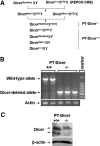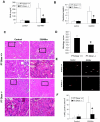Targeted deletion of Dicer from proximal tubules protects against renal ischemia-reperfusion injury
- PMID: 20360310
- PMCID: PMC2865746
- DOI: 10.1681/ASN.2009070718
Targeted deletion of Dicer from proximal tubules protects against renal ischemia-reperfusion injury
Abstract
MicroRNAs are endogenous, noncoding, small RNAs that regulate expression and function of genes, but little is known about regulation of microRNA in the kidneys under normal or pathologic states. Here, we generated a mouse model in which the proximal tubular cells lack Dicer, a key enzyme for microRNA production. These mice had normal renal function and histology under control conditions despite a global downregulation of microRNAs in the renal cortex; however, these animals were remarkably resistant to renal ischemia-reperfusion injury (IRI), showing significantly better renal function, less tissue damage, lower tubular apoptosis, and improved survival compared with their wild-type littermates. Microarray analysis showed altered expression of specific microRNAs during renal IRI. Taken together, these results demonstrate evidence for a pathogenic role of Dicer and associated microRNAs in renal IRI.
Figures




Similar articles
-
miR-17-92 ameliorates renal ischemia reperfusion injury.Kaohsiung J Med Sci. 2018 May;34(5):263-273. doi: 10.1016/j.kjms.2017.09.003. Epub 2017 Oct 27. Kaohsiung J Med Sci. 2018. PMID: 29699633 Free PMC article.
-
Dicer deficiency in proximal tubules exacerbates renal injury and tubulointerstitial fibrosis and upregulates Smad2/3.Am J Physiol Renal Physiol. 2018 Dec 1;315(6):F1822-F1832. doi: 10.1152/ajprenal.00402.2018. Epub 2018 Oct 3. Am J Physiol Renal Physiol. 2018. PMID: 30280598 Free PMC article.
-
miR-214 represses mitofusin-2 to promote renal tubular apoptosis in ischemic acute kidney injury.Am J Physiol Renal Physiol. 2020 Apr 1;318(4):F878-F887. doi: 10.1152/ajprenal.00567.2019. Epub 2020 Jan 31. Am J Physiol Renal Physiol. 2020. PMID: 32003595 Free PMC article.
-
Dicer cuts the kidney.J Am Soc Nephrol. 2008 Nov;19(11):2043-6. doi: 10.1681/ASN.2008090986. Epub 2008 Oct 15. J Am Soc Nephrol. 2008. PMID: 18923053 Review. No abstract available.
-
Vascular and circulating microRNAs in renal ischaemia-reperfusion injury.J Physiol. 2015 Apr 15;593(8):1777-84. doi: 10.1113/JP270318. Epub 2015 Mar 31. J Physiol. 2015. PMID: 25691473 Free PMC article. Review.
Cited by
-
miR-127 protects proximal tubule cells against ischemia/reperfusion: identification of kinesin family member 3B as miR-127 target.PLoS One. 2012;7(9):e44305. doi: 10.1371/journal.pone.0044305. Epub 2012 Sep 4. PLoS One. 2012. PMID: 22962609 Free PMC article.
-
A MicroRNA Cluster miR-23-24-27 Is Upregulated by Aldosterone in the Distal Kidney Nephron Where it Alters Sodium Transport.J Cell Physiol. 2017 Jun;232(6):1306-1317. doi: 10.1002/jcp.25599. Epub 2017 Jan 5. J Cell Physiol. 2017. PMID: 27636893 Free PMC article.
-
MicroRNAs and fibrosis.Curr Opin Nephrol Hypertens. 2012 Jul;21(4):410-6. doi: 10.1097/MNH.0b013e328354e559. Curr Opin Nephrol Hypertens. 2012. PMID: 22622653 Free PMC article. Review.
-
Dicing the Disease with Dicer: The Implications of Dicer Ribonuclease in Human Pathologies.Int J Mol Sci. 2020 Sep 30;21(19):7223. doi: 10.3390/ijms21197223. Int J Mol Sci. 2020. PMID: 33007856 Free PMC article. Review.
-
The regulation and function of microRNAs in kidney diseases.IUBMB Life. 2013 Jul;65(7):602-14. doi: 10.1002/iub.1174. IUBMB Life. 2013. PMID: 23794512 Free PMC article. Review.
References
-
- Bonventre JV, Weinberg JM: Recent advances in the pathophysiology of ischemic acute renal failure. J Am Soc Nephrol 14: 2199–2210, 2003. - PubMed
-
- Devarajan P: Update on mechanisms of ischemic acute kidney injury. J Am Soc Nephrol 17: 1503–1520, 2006. - PubMed
-
- Molitoris BA: Transitioning to therapy in ischemic acute renal failure. J Am Soc Nephrol 14: 265–267, 2003. - PubMed
Publication types
MeSH terms
Substances
Grants and funding
LinkOut - more resources
Full Text Sources
Other Literature Sources
Molecular Biology Databases

